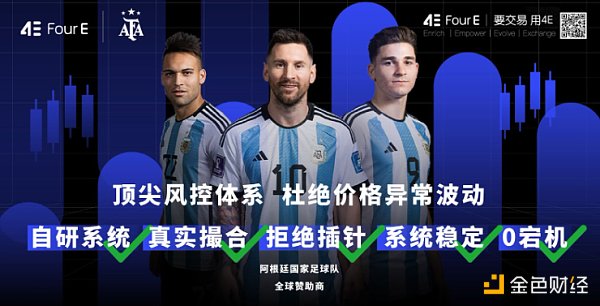In recent years, contract trading has exploded. Almost all platforms on the market have launched contract trading sections, and more and more investors have joined the "contract" boom market.
However, the extreme market conditions brought about by successive turmoil have caused some platforms to frequently "unplug the network cable" and "plug the pin". The market is in chaos, fixed-point liquidation and malicious manipulation are commonplace, and user rights are not guaranteed. This has led to investors facing contract products with great industry cognitive bias and selection barriers, and they are also very cautious in entering the market. It is precisely in this regard that 4E has made the design of risk control mechanisms a top priority in the development stage of contract products.
Since the launch of 4E contracts, it has experienced several large and small extreme market shocks, and there has not been a single plug-in or downtime incident. Behind this is 4E's practice of the "long-termism" development concept and the consistent "do no evil" values, and it is also a reflection of its own strong risk control capabilities.

Fair price index
In the contract market, many platforms have had a black history of abnormal fluctuations in the market price, which has led to user liquidation, which is what we often call "pin insertion".
This phenomenon is related to the lack of liquidity of most trading platforms and the imperfection of risk control mechanisms. The most direct factor is that the liquidation price used is unreasonable. For example, many immature platforms use the latest transaction price in the contract market as the price scale, which is single and rough in dimension and can be easily manipulated by large funds.
We know that the price of a contract depends on the spot price of the underlying asset. Ideally, the price of the contract (the latest price) follows the spot price trend of the underlying asset. However, this is not always the case, because contracts have their own market and their own supply and demand dynamics, which often lead to differences between the contract price and the spot price of its underlying asset. If the latest transaction price of the contract market is used, it is easy to be manipulated.
In response to this, 4E Contract uses the mark price as a condition to trigger forced liquidation. Compared with the latest price of the contract, the mark price fluctuates less in the short term, so it can better estimate the "real" value of the contract, thereby preventing unnecessary forced liquidation caused by abnormal fluctuations in the market, effectively avoiding malicious manipulation of the market by large investors, protecting small and medium-sized traders in the market, and ensuring market stability. This mechanism is at the leading level in the industry and has been recognized and trusted by 4E Contract traders.
The formation of the 4E mark price is formed by the weighted average of the corresponding spot quotes of multiple platforms, and the index price, the basis rate of the funding cost, and the depth weighted middle price are calculated comprehensively. It has the characteristics of diverse price sources, rigorous, reasonable and transparent calculations, and can effectively smooth prices, thereby causing unnecessary forced liquidation and triggering the risk of chain forced liquidation.
In other words, the liquidation price depends on the weighted result of multiple price mechanisms. In extreme market conditions, if a large investor with an advantage in funds in the market wants to maliciously manipulate the real-time market of the contract for a short period of time, it is not enough to control the latest price, but it is also necessary to control the mark price. In this way, the risk difficulty and cost are huge, and the probability of occurrence is extremely small.
Anti-manipulation position limit and price limit mechanism
Secondly, the 4E contract strictly limits the user's position, order quantity, opening and closing prices, etc. to prevent market manipulation.
In terms of position limits, 4E implements a tiered maintenance margin system. When the account equity exceeds a certain range, the opening margin will change. The larger the position, the higher the margin required and the lower the leverage ratio. The tiered maintenance margin system will reduce the risk of large positions, maintain the stability of the contract market, and will not affect ordinary users.
4E Contract also limits the amount of orders placed by users to avoid large orders from crashing the market.
In addition, the price limit mechanism is one of the important risk control measures to prevent market manipulation and protect users. 4E Contract sets price limits on the order prices of users of different currency contracts.

Friendly forced liquidation mechanism
In the forced liquidation mechanism, 4E adopts a partial forced liquidation process to reduce the risk limit and reduce the maintenance margin requirement to avoid all positions being forced to be liquidated directly.
When the mark price reaches the forced liquidation price displayed in the position area, the forced liquidation system will take over the trader's position. After the forced liquidation engine takes over the position, the system will first determine the current margin level used.
If the position is taken over at the lowest margin level, the system will first cancel all unfulfilled orders for this contract. If the maintenance margin requirement is not met at this time, this position will be taken over by the liquidation engine at the bankruptcy price.
If the position is taken over at the second or higher margin level, the system will first cancel the unfulfilled orders for this contract, but retain the existing position to reduce the user's margin level. If it is still not met, it will submit a full execution or cancel the order immediately. The value of this order is equal to the difference between the current position value and the margin level that meets the current margin requirements to avoid further liquidation. Finally, if the position is still in a forced liquidation state, the position will be taken over by the liquidation engine at the bankruptcy price.

The entire forced liquidation process is divided into 3 steps. When the position has sufficient initial margin and meets the maintenance margin requirements, the system will stop forced liquidation.
The 4E mechanism can not only more effectively prevent users from having all their positions liquidated at once, further reduce the impact of too many forced liquidation orders on the market, but also greatly help users reduce the risk of forced liquidation and retain their positions and rights as much as possible.
Since its launch, as a leader in the contract market, 4E has insisted on protecting the interests of investors and constantly improving contract details. Under the protection of a strict risk control system, 4E has gained the trust of users, and its trading volume has continued to rise, winning the recognition of many investors.
 Huang Bo
Huang Bo









